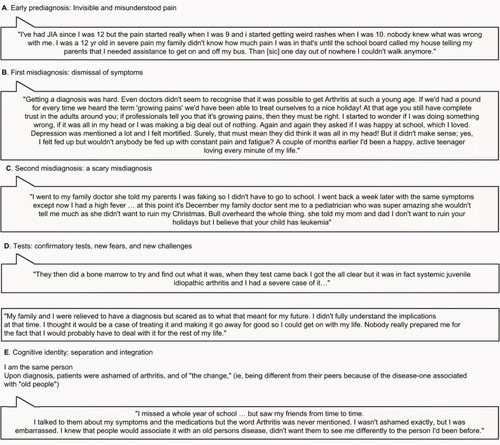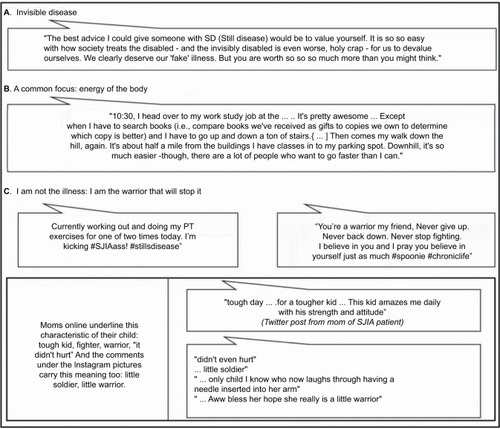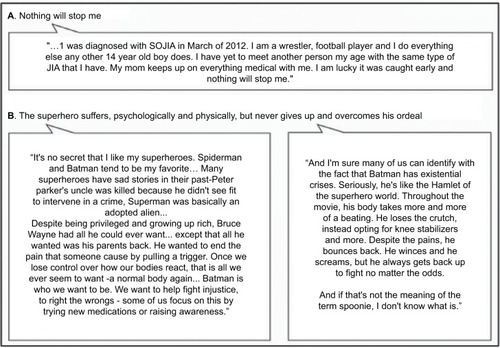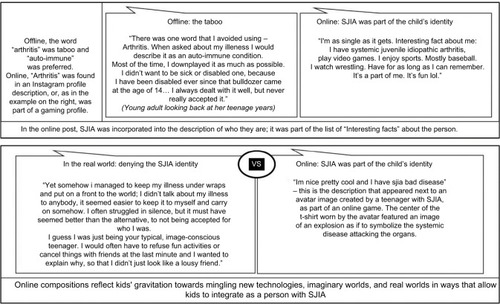Abstract
Purpose
To understand the experience of adolescent systemic juvenile idiopathic arthritis (SJIA) patients and those of their parents based on their social media posts.
Methods
English language posts related to SJIA, Still’s disease, or juvenile arthritis were collected and analyzed.
Results
In total, 71 posts created between 2009 and 2015 on 15 websites were identified in November 2015. Of the 32 unique authors, 17 were SJIA patients aged 13–20 years (40 posts), 7 were mothers of SJIA patients (12 posts), and 8 patients had unspecified forms of juvenile arthritis (19 posts). Many patients posted about similar diagnostic experiences marked by 5 phases: 1) early prediagnosis: pain and fatigue overlooked until crisis occurred, 2) first misdiagnosis: doctors talked about “growing pains” and psychosocial problems (“fake pains” to avoid school), 3) second misdiagnosis: severity acknowledged, but diagnosed as leukemia or another cancer, 4) tests: tests leading to diagnosis and treatment conducted, and 5) cognitive identity: patient accepted the diagnosis and its implications. Many adolescent patients, looking back at disease onset in their childhood, described themselves as a “sleeping child” rather than the typical active child. Several patients tried to hide their illness from friends, but expressed concerns openly online. Many patients described SJIA as a powerful external enemy, using terms like “bulldozer,” “dragon,” and “monster.” Many posts from patients and their mothers used superhero language/imagery to help “fight” SJIA. Some patients also posted about the risk of death.
Conclusion
Although most adolescent SJIA patients openly posted about the difficulties of their disease online, they made efforts to hide their disease in the real world. They frequently used superhero words and images in describing their fight for better health. Physicians can use these insights when counseling SJIA patients to provide a narrative that meshes with the patients’ worldview and perhaps to improve physician–patient communication to increase treatment adherence.
Introduction
Systemic juvenile idiopathic arthritis (SJIA), also known as Still’s disease, is a rare autoinflammatory form of chronic arthritis in pediatric patients, characterized by spiking fever, skin rash, arthralgia or arthritis, myalgia, hepatosplenomegaly, lymphadenopathy, and serositis.Citation1,Citation2 SJIA represents 4%–17% of all juvenile idiopathic arthritis (JIA) cases worldwide,Citation2 and accounts for 5%–10% of all JIA cases in the USA and Europe.Citation1,Citation3,Citation4 It affects the health-related quality of life of patients, impacts functioning in school and at home, and imposes a significant social and economic burden on patients and their families.Citation5–Citation7
To minimize the impact of SJIA on the physical and psychosocial development of patients, it is essential to know patients’ perspectives about the disease and associated factors. Social media posts from patients and their caregivers are helpful in obtaining important real-world patient-focused information related to patient needs and the disease burden on their lives. Understanding how patients and caregivers process this information could facilitate better understanding by health care professionals of the patients’ conditions to better assess treatment effectiveness and help counsel appropriately.Citation8
Prior work has identified social media posting behaviors of parents of children with potential SJIA, as well as of parents of diagnosed children, in the time periods before and after SJIA diagnosis, showing the impact of the disease journey on the families.Citation9 The objective of this study was to understand the experience of adolescent SJIA patients and those of their parents evident from their own social media posts.
Methods
In this study, posts that indicated a direct reference to the disease (SJIA/Still’s disease or juvenile arthritis [JA]) and posted by adolescent patients were collected and manually analyzed by a linguistic analysis team (Treato, Princeton, NJ, USA). In addition, posts from caregivers talking about childhood or adolescent experiences of patients with SJIA were collected and analyzed. The dataset was obtained from existing publicly available sites and posts (i.e., posts viewable by all and not requiring a password to access) and was limited to English-language public social media (Facebook, Instagram, Tumblr, and Twitter). The majority of the posts were collected from the USA; however, some posts were also collected from the UK and Canada owing to similarities in disease experience.
Tools from sociolinguistics (mainly praxematics) and semiotics were applied to both word posts and visual posts (i.e., posts using memes, gifs, and pictures) to understand the cognitive relationship between young patients and their disease. Evaluation of semantic networks, rhetoric supports (metaphors, symbols, and ellipses), and recurrence of representational schemes (concepts, representations, and stereotypes) allowed for an understanding of the patients’ socio-cognitive patterns in relation to their disease. No ethical approval or informed consent was obtained as the posts were retrieved from public, open-access websites.
Results
In total, 71 posts created between 2009 and 2015 on 15 websites were reviewed in November 2015. Of the 24 unique authors identified, 17 were SJIA patients (40 posts) and 7 were mothers of SJIA patients (12 posts; ). Moreover, there were 8 unique JA patients (19 posts; using the term JA, JIA, or juvenile rheumatoid arthritis without mentioning SJIA) included in the analysis to compare the specific mention of SJIA with these less-specific posts. Patients whose posts were included were between 13 and 20 years of age, as determined from patient/caregiver declarations in the posts. Some posts were included because the patients talked about their past school and teenage years, although they did not reveal their current age; however, the subtext and context showed that they were in their mid-20s when they posted them ().
Table 1 Number of posts by patients and mothers on public social media sites
Table 2 Number of posts by adolescent patients
Patients’ experiences with SJIA
Our analysis of social media posts from SJIA patients revealed 5 diagnosis-related phases: early prediagnosis, first misdiagnosis, second misdiagnosis, tests, and cognitive identity (). These phases, which surfaced in several patients’ posts, are similar to the phases identified in the preceding SJIA social media study with younger patients.Citation9 Each phase was characterized by certain language behaviors that demonstrated the journey of their emotional experience. Many posts described experiences of children falling ill during the early prediagnosis phase, with no knowledge regarding the cause of pain and intense fatigue. Several adolescent patients, while looking back at the onset of the disease when they were children, described themselves as a “sleeping child” rather than a typical active, playful child (). The same posts described how no family member takes action until the patient’s body “stops working,” and the patient was incapable of going to school or even getting out of bed. In addition, most doctors initially misdiagnosed SJIA as “growing pains” or infection. One child posted that all the doctors she initially visited did not diagnose arthritis from her symptoms and instead used the words “growing pains” or questioned her willingness to go to school or her mental state (). Patients stated that as time passed without diagnosis and the illness worsened over time, parents finally took the child to a specialist during the late prediagnosis phase. However, doctors often misdiagnosed it again (), and the second misdiagnosis would be scarier than the first; in general, leukemia or another cancer was suspected. Patients mentioned that they and their families were relieved after the final and true diagnosis of SJIA and knowing that it can be treated. However, the relief was for a short duration, with the relief receding when they came to understand that SJIA cannot be cured with treatment (). After diagnosis of SJIA, patients found it difficult to integrate “the new me” into their identity and life, and they talked about embarrassment or shame; they feared people would associate their arthritis with the typical arthritis experienced by old people. Many adolescent patients wanted to adhere to their pre-illness identity, to conceal the disease from their peers, so that they could remain as normal or similar to their peers as possible ().
Figure 1 Social media posts from patients with SJIA or their caregivers regarding the experience of diagnosis through 5 phases.
Abbreviations: JIA, juvenile idiopathic arthritis; SJIA, systemic juvenile idiopathic arthritis.

Emotional impact of SJIA on adolescents
Posts from adolescents showed that they posted online about the difficulties of their disease; however, in the real world, they tried to conceal their disease. Posts demonstrated that adolescent patients preferred to use other names for SJIA, such as “autoimmune [sic] disease,” instead of SJIA or arthritis in the physical world. In the real world, adolescents reported that they acted as if they were persons with no pain or real reasons to skip joining friends at the mall or pool. They also struggled to prevent the “sleeping child” from becoming a “sleeping teenager.” However, this is a challenge given the toll the disease can take on their ability to engage in similar activities performed by their healthy counterparts at an equal level (). On the contrary, in the online community, adolescent patients accepted SJIA as a part of their identity and expressed their pain and despair associated with the disease ().
Patients’ description of SJIA
SJIA patients expressed anger and described SJIA as an invisible disease () and a powerful external enemy attacking their body by using terms, such as “bulldozer,” “dragon,” and “monster.” The term “Still’s” was also used, but only by older adolescents. Patients shared hashtags, such as #stillssucks, #notstandingstillsdisease, and #ihatearthritis. Many patients have adopted the term “spoonie” to describe themselves as someone living with a chronic disease; the term originated in the autoimmune community to describe how people with chronic conditions manage their energy throughout the day (). This term was coined by a lupus patient during an explanation given to a friend in a restaurant using the spoons on the table as symbols of units of energy to be sparingly used throughout the day: imagine you start each day with 8 spoons of energy, if you use 6 in the morning because you go shopping, you have only 2 left to finish the day with. SJIA teenagers relate to the “spoonie” conceptualization and feel part of this community.Citation10 SJIA patients described the lack of energy as a significant challenge to living a normal adolescent life. shows an image of how climbing stairs was a physical challenge for a SJIA patient in college.
Figure 3 Patients’ description of SJIA.

Posts demonstrated that patients did not feel associated with their disease and imagined SJIA as an external enemy that they have to fight. The warrior image of themselves was frequent in the representations shared online () and aligns with the monster conceptualization of the disease. Mothers of SJIA patients also used warrior-child imagery and language in their posts ().
Along with the warrior image of themselves, numerous patients used superhero language or imagery in their social media posts to help them “fight” the disease and its burden, based on the idea that superheroes can fight dragons and monsters. A 14-year-old patient mentioned that he felt lucky his disease was caught earlier and that nothing can stop him from living a normal life like other boys of his age ().
Figure 4 Social media posts from adolescents and their parents on how to fight SJIA.

Patients mentioned that superheroes are not only strong and fearless enough to fight monsters, lift and destroy bulldozers, and eradicate dragons (which are the concepts used to describe the disease), but they also have a special history (). SJIA patients used writings to appreciate what they share with superheroes; similar to the adolescent SJIA patients, most superheroes discovered an alienation of self in their own childhoods (). Superheroes overcame their alienation (e.g., Batman from his beloved murdered parents) by choosing to be strong and fighting back, a response the kids appreciated and aimed to model in their own life and world ().
SJIA and death
Adolescent SJIA patients and their parents posted about the risk of death related to JA and SJIA or shared stories about the death of other SJIA patients, which were distinct from patients suffering from other forms of JA. Three of the posts related to death posted by SJIA patients/caregivers are presented in .
Figure 5 Social media posts from adolescents with SJIA and their parents on death*. (No reference to death was made in posts from patients who posted as having JA, JRA, or JIA).
Abbreviations: JA, juvenile arthritis; JIA, juvenile idiopathic arthritis; JRA, juvenile rheumatoid arthritis; SJIA, systemic juvenile idiopathic arthritis; SOJIA, systemic onset juvenile idiopathic arthritis.

Discussion
We analyzed social media posts from adolescent SJIA patients to examine the impact of SJIA on the physical, social, and emotional aspects of patients and their families. Posts regarding childhood were studied to understand adolescents’ perspectives on their diagnosis and history with SJIA, and posts from patients in their 20s were studied if they provided a view on their adolescent years. In this study, patients’ experience of SJIA diagnosis was categorized in 5 phases, as reported previously by Modica et al.Citation9 As a result of misdiagnosis, patients encountered considerable stress and needless suffering. This also broke the confidence of some of the patients in their health care providers. The issue of misdiagnosis may stem, in a great part, from the difficulty in accessing pediatric rheumatologists in many parts of the country.Citation11 Delays in diagnosis and gaps in communication with health care providers not only affects the patients but also leads to frustration and distress among the caregivers.Citation9 Patients and parents of children with other chronic diseases also reported experiencing confusion and distress before and after the diagnosis of the disease.Citation12–Citation15 Our findings confirm that accurate diagnosis of the disease provides relief to patients and their families. However, once a patient is aware of the fact that there is only treatment and no cure for SJIA, one of the difficult aspects for patients, particularly adolescents, is the loss of “normal” life for the forseeable future, and this is stressful for patients as well as caregivers of SJIA patients. The importance of “being normal” has also been demonstrated in adolescent patients with other chronic diseases.Citation16
We observed that adolescents with SJIA prefer to adhere to their pre-illness identity and conceal the disease from their peers so that they can remain as normal or similar to their peers as possible. It was also observed for adolescents with JA in general and chronic illnesses.Citation16–Citation18 The fear of being stigmatized, which prevented SJIA patients from revealing their disease, is also reflected in other long-term diseases, including rheumatoid arthritis, chronic back pain, cancer, acquired immunodeficiency syndrome, and mental disorders.Citation19–Citation25 Similar to patients with rheumatoid arthritis, adolescent SJIA patients were ashamed and embarrassed of being perceived as abnormal and feared discrimination. Furthermore, concurrently, patients diagnosed with SJIA have a basic need to express their emotions about the illness they experience. Patients resolve these opposing needs by going online where they find disease- and non-disease-specific communities and forums to talk about the difficulties of living with the disease. This helps them unburden the emotional weight of the disease by giving voice to the unending challenges it brings, outside the lens of their real-world peers.
Young patients used their online writing and imagery choices to describe their disease and express their true feelings about the disease and what they aim for in real life. Patients preferred to use other names for SJIA as they wanted to avoid association with the word “arthritis,” because the word “arthritis” is associated with being “old” and kids are quite sensitive to such potential perceptions of them by others. Online, some patients described SJIA as an “autoimmune disease,” although it is an autoinflammatory disease, a nomenclature issue that may stem from lack of adequate knowledge of patients about the disease.
SJIA was described as coming from the outside and attacking them, an attacker they express feelings of hatred against, as it affects their psychosocial potential, physical and mental health, and overall well-being.
Adolescents also used superhero language/imagery to build the fortitude they need to persevere through the disease and to be as normal as possible offline, among their real-world peers. Imageries of superheroes are important for SJIA adolescents, including girls to fight SJIA. Social media posts and reports on using superhero narratives to cope with long-term disease have been documented in patients with other disorders, including cancer, JIA, and rheumatoid arthritis.Citation21,Citation26,Citation27 The “illusive” aspect of the monster or the dragon hark back to the prediagnosis period, when the child’s credibility or truthfulness was called into question-the invisible disease causing family physicians to suggest that SJIA was nothing more than a child faking an illness to avoid school. This period presented the first fissures in a patient’s image. However, this symbolical illusive aspect can also be linked to the fact that adolescents do not mention visible symptoms or handicap (versus JA patients); instead, they frequently talk about SJIA as the “invisible illness” that is hard to fight and integrate in to their identity. Opposing the illness and hating it keeps the boundaries up between “I” (the patient) and “it” (the disease). The patients’ methods of battling “it” involve being stronger than the disease (e.g., exercise 2 times a day, go to class then to work, date), but that also goes with denying their disease in real life. The use of metaphors to describe the illness and cope with it is common in pediatric as well as adult patients with other diseases as well.Citation28,Citation29 We observed that some patients and their parents struggled with a fear of death due to the association of SJIA with death. The threat of death due to chronic disease has also been documented in patients and families of children with other disorders, including Marfan syndrome and cancer.Citation12,Citation23 Interestingly, adolescents self-identify themselves on non-disease-specific online locations, including gaming locations or on Twitter (e.g., “my hips don’t lie, they really freaking hurt,” the first phrase from a Shakira song and the second creatively playing off Shakira’s line); peers from school might find these profiles, which may explain the low number of identifiable SJIA adolescents talking online on open forums.
These findings should be interpreted in light of the qualitative nature of the study and the small sample size. Most patients were from the USA, so our findings may not reflect the diagnostic experience of all SJIA patients. The posts from SJIA patients were collected between 2009 and 2015 and may be markedly different now, given that there are more therapeutic options approved for the treatment of SJIA (e.g., interleukin [IL]-1/IL-6 inhibitors).Citation30,Citation31
Conclusion
Adolescent SJIA patients posted openly about the difficulties of their disease that were causing them to be different from their healthy peers, whereas in the real world, they tried to minimize or hide the effects of their disease. Adolescent SJIA patients frequently used narratives and images of superheroes in their posts to describe their fight for health. Physicians can use these insights when counseling adolescent SJIA patients to provide a narrative that meshes with patients’ worldview, and perhaps to improve physician–patient communication to increase treatment adherence. Nevertheless, medical teams could also encourage adolescents to seek help for endorsing the disease in real life; hiding can be adding weight to the burden, and although expressing themselves online through modern social media may help considerably, it still instills a cognitive schism that demands organization and division of the “Self.”
Author contributions
RFM and AC designed the research, identified the samples, analyzed and interpreted data, and drafted and edited the article. PB contributed to design and implementation of research and edited the article. KGL contributed to the analysis of the results and to the writing of the article. All authors discussed the results and approved the article for publication.
Acknowledgments
We thank the patients and their families that shared their posts online, and thus their thoughts were available for inclusion in this study. The authors thank Amit Agarwal (Novartis Healthcare Pvt Ltd, Hyderabad, India) for medical writing and editorial support. This research was funded by Novartis Pharmaceuticals Corporation. The authors had full control of the contents of this article. The abstract of this paper was presented at the EULAR (The European League Against Rheumatism) 2016 Congress as a poster presentation with interim findings. The poster’s abstract was published in “Poster Abstracts” in Annals of the Rheumatic Diseases: http://dx.doi.org/10.1136/annrheumdis-2016-eular.3240.
Disclosure
KGL is an employee of Novartis Pharmaceuticals Corporation. The other authors report no conflicts of interest in this work.
References
- BruckNSchnabelAHedrichCMCurrent understanding of the pathophysiology of systemic juvenile idiopathic arthritis (sJIA) and target-directed therapeutic approachesClin Immunol20151591728325956529
- RavelliAMartiniAJuvenile idiopathic arthritisLancet2007369956376777817336654
- MellinsEDMacaubasCGromAAPathogenesis of systemic juvenile idiopathic arthritis: some answers, more questionsNat Rev Rheumatol20117741642621647204
- CorrellCKBinstadtBAAdvances in the pathogenesis and treatment of systemic juvenile idiopathic arthritisPediatr Res2014751–217618324213625
- BaileyKMMcDonaghJEPrieurAMSystemic juvenile idiopathic arthritis presenting in a young child with long-term disability as an adolescentAnn Rheum Dis200463121544154815547076
- AmineBRostomSBenbouazzaKAbouqalRHajjaj-HassouniNHealth related quality of life survey about children and adolescents with juvenile idiopathic arthritisRheumatol Int200929327527918690442
- MindenKNiewerthMListingJBiedermannTSchöntubeMZinkABurden and cost of illness in patients with juvenile idiopathic arthritisAnn Rheum Dis200463783684215194580
- BenetoliAChenTFAslaniPHow patients’ use of social media impacts their interactions with healthcare professionalsPatient Educ Couns2018101343944428882545
- ModicaRFLomaxKGBatzelPShapardanisLKatzerKCElderMEThe family journey-to-diagnosis with systemic juvenile idiopathic arthritis: a cross-sectional study of the changing social media presenceOpen Access Rheumatol20168617127843371
- MiserandinoCThe spoon theory Available from: https://butyoudontlooksick.com/articles/written-by-christine/the-spoon-theoryAccessed February 02, 2018
- McErlaneFFosterHECarrascoRTrends in paediatric rheumatology referral times and disease activity indices over a 10-year period among children and young people with Juvenile Idiopathic Arthritis: results from the childhood arthritis prospective studyRheumatology (Oxford)20165571225123427016664
- KelleherEGiampietroPFMorenoMAMarfan syndrome patient experiences as ascertained through postings on social media sitesAm J Med Genet A2015167A112629263426272787
- NelsonPAKirkSACaressALGlennyAMParents’ emotional and social experiences of caring for a child through cleft treatmentQual Health Res201222334635921890716
- McKechnieACPridhamKPreparing heart and mind following prenatal diagnosis of complex congenital heart defectQual Health Res201222121694170622927700
- KirkpatrickSLocockLFarreARyanSSalisburyHMcDonaghJEUntimely illness: when diagnosis does not match age-related expectationsHealth Expect Epub201829
- HartRIMcDonaghJEThompsonBBeing as normal as possible: How young people ages 16–25 years evaluate the risks and benefits of treatment for inflammatory arthritisArthritis Care Res (Hoboken)20166891288129427040737
- McDonaghJEShawKLPrescottJSmithFJRobertsRGrayNJ“Sometimes I feel like a pharmacist”: identity and medication use among adolescents with juvenile arthritisPediatr Rheumatol Online J20161415727756328
- KaushanskyDCoxJDodsonCMcNeeleyMKumarSIversonELiving a secret: disclosure among adolescents and young adults with chronic illnessesChronic Illn2017131496127343016
- KostovaZCaiata-ZuffereyMSchulzPJThe process of acceptance among rheumatoid arthritis patients in Switzerland: a qualitative studyPain Res Manag2014192616824527466
- EcclestonCWilliamsACRogersWSPatients’ and professionals’ understandings of the causes of chronic pain: blame, responsibility and identity protectionSoc Sci Med19974556997099226793
- Michael Trouble’s on a mission Available from: http://michaeltrouble.com/parents/Accessed February 05, 2018
- EladPYagilYCohenLMellerIA jeep trip with young adult cancer survivors: lessons to be learnedSupport Care Cancer200311420120612673458
- KnappSMarzilianoAMoyerAIdentity threat and stigma in cancer patientsHealth Psychol Open201411110
- RintamakiLSDavisTCSkripkauskasSBennettCLWolfMSSocial stigma concerns and HIV medication adherenceAIDS Patient Care STDS200620535936816706710
- CorriganPWWatsonACUnderstanding the impact of stigma on people with mental illnessWorld Psychiatry200211162016946807
- MendelsonARabinowiczNReisYComics as an educational tool for children with juvenile idiopathic arthritisPediatr Rheumatol Online J20171516928865469
- RA Guy Foundation: 60-second guide to rheumatoid arthritis Available from: https://www.raguyfoundation.org/resources/60-second-guide/Accessed February 05, 2018
- HarringtonKJThe use of metaphor in discourse about cancer: a review of the literatureClin J Oncol Nurs201216440841222842692
- WeissMSignifying the pandemics: metaphors of AIDS, cancer, and heart diseaseMed Anthropol Q19971144564769408901
- GiancaneGMinoiaFDavìSBraccioliniGConsolaroARavelliAIL-1 inhibition in systemic juvenile idiopathic arthritisFront Pharmacol2016746727999545
- CannySMellinsENew frontiers in the treatment of systemic juvenile idiopathic arthritisF1000Res2017697128690841

